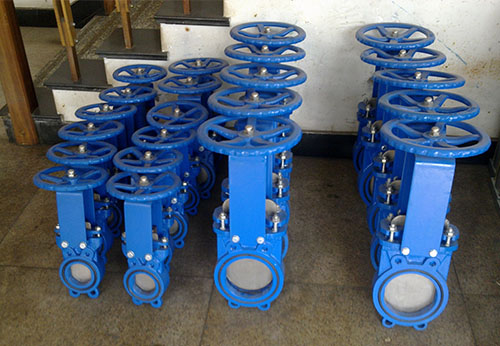Correct installation method of knife gate valve
Posted by Bundor valve
Knife gate valves are mainly used in pipeline systems containing particles or solid media, such as sewage treatment, slurry transportation, etc. Their design facilitates rapid opening and closing and cutting of solid particles. The following is the correct installation method of knife gate valves:

First, before installing the knife gate valve, make sure that all pipes have been cleaned to avoid residual impurities affecting valve performance. At the same time, check whether the valve and pipeline match, and confirm that the valve caliber and pressure level meet the system requirements.
Secondly, when installing the knife gate valve, the gate should be in a fully open or fully closed state, which can reduce the wear between the gate and the sealing surface. The valve should be installed vertically on the pipeline, and the connection between the valve body and the pipeline should be kept parallel and aligned to avoid stress concentration.
Then, when connecting the valve, use suitable supports and fixtures to fix the valve body to prevent the valve from deforming or shifting due to pipeline stress. For larger knife gate valves, special brackets and fasteners should be used according to the manufacturer's instructions.
Next, ensure that the sealing performance between the valve and the pipeline is good. Use suitable sealing materials to fill the gap on the end face of the valve to ensure that there is no leakage. When bolting the valve, the nuts should be tightened evenly in diagonal order to avoid uneven stress causing valve deformation.
Finally, after the installation is completed, perform a pressure test to check for leaks and ensure that the valve can work properly. At the same time, carry out operational tests to check whether the valve opens and closes smoothly and whether the gate can be fully opened and closed.
Secondly, when installing the knife gate valve, the gate should be in a fully open or fully closed state, which can reduce the wear between the gate and the sealing surface. The valve should be installed vertically on the pipeline, and the connection between the valve body and the pipeline should be kept parallel and aligned to avoid stress concentration.
Then, when connecting the valve, use suitable supports and fixtures to fix the valve body to prevent the valve from deforming or shifting due to pipeline stress. For larger knife gate valves, special brackets and fasteners should be used according to the manufacturer's instructions.
Next, ensure that the sealing performance between the valve and the pipeline is good. Use suitable sealing materials to fill the gap on the end face of the valve to ensure that there is no leakage. When bolting the valve, the nuts should be tightened evenly in diagonal order to avoid uneven stress causing valve deformation.
Finally, after the installation is completed, perform a pressure test to check for leaks and ensure that the valve can work properly. At the same time, carry out operational tests to check whether the valve opens and closes smoothly and whether the gate can be fully opened and closed.
 简体中文
简体中文 Русский
Русский Español
Español Bundor - Butterfly, Gate, Check, Ball, Globe Valve Manufacturer, Supplier & Distributor
Bundor - Butterfly, Gate, Check, Ball, Globe Valve Manufacturer, Supplier & Distributor
